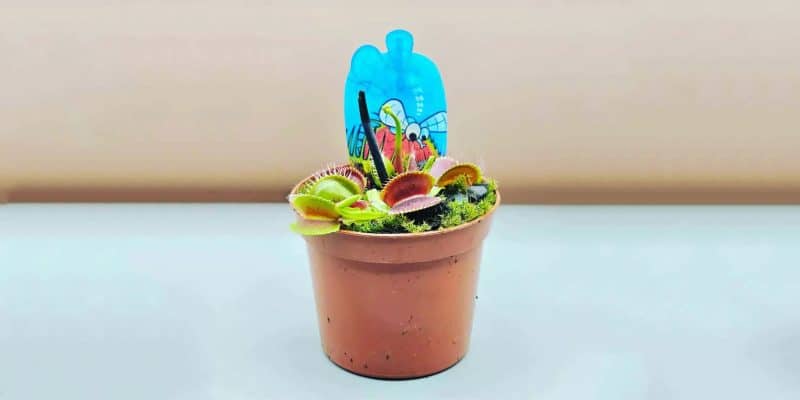Charles Darwin once called the Venus fly trap “one of the most wonderful plants in the world.” And if he lived in North Carolina, he would have discovered one much earlier.
That’s right — this quirky little carnivore, with its striking colors and jaw-like traps, is surprisingly native to North America and not a far-off exotic place.
Besides its obvious appetite for insects, the Venus fly trap is an evolutionary star, thriving in a nutrient-poor environment where most plants would wither away. No wonder Darwin was so taken by it.
In this guide, we’ll cover everything you need to know about Venus fly trap care, from creating the ideal environment for your new carnivorous buddy to understanding its insect-eating habits and winter dormancy.
Ready to be entrapped (okay, more like entranced) by one of the most fascinating plants on the planet? Let’s get growing!
Table of Contents
Venus Flytrap Plant Care Guide
History, Habitat, and Characteristics
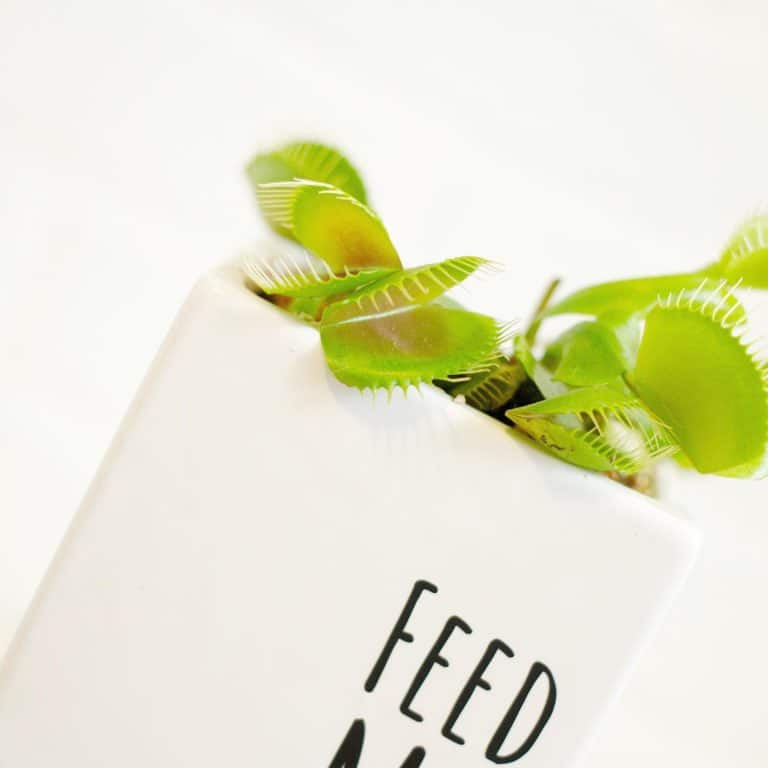
The Venus fly trap (Dionaea muscipula) might just be the most fascinating houseplant you’ll ever meet! Who knew that this captivating carnivore from the Droseraceae family actually hails from the bogs and wetlands of North and South Carolina, rather than some distant tropical paradise?
The beauty of the Venus fly trap isn’t just in its carnivorous ways, but also in its vibrant green and red colors. Give it plenty of light, and it’ll reward you by showing off vivid hues both inside and outside its traps.
Each trap is actually two modified leaves attached by a hinge, and your plant can have up to eight. (The purple pitcher plant is also one of few carnivorous plants with modified leaves).
You might be thinking, “Doesn’t a carnivorous plant need to live somewhere tropical?” Surprisingly, no! It goes through a winter dormancy period from late autumn to spring. It’s also adapted to the nutrient-poor soil in the bogs of its native habitat by eating insects.
How Does a Venus Fly Trap Eat?
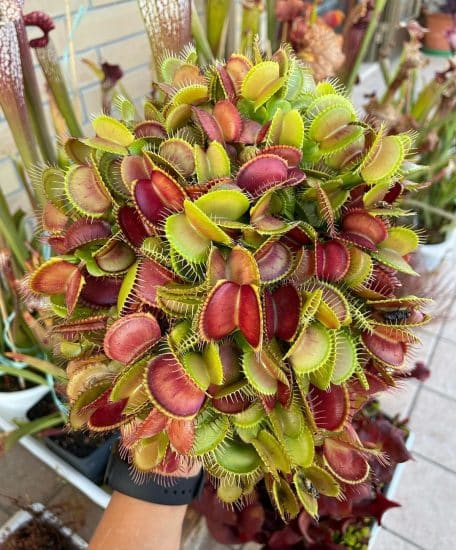
So how does this whole feeding thing work? With the help of its sweet nectar and attractive red coloring, the Venus fly trap lures all sorts of unsuspecting insects straight into its traps. It’ll happily dine on ants, spiders, beetles, grasshoppers — you name it! Talk about having an all-you-can-eat buffet at home!
When an insect touches any two of the six small hairs called trichomes on the plant’s lobes, these trigger hairs snap shut within half a second.
This type of movement is called thigmonasty — a nondirectional plant response to being touched.
When the insect continues to struggle, the cage (spines on the leaf’s edge) squeezes shut tightly. Then, glands on the leaf surface emit a sap that digests the insect to absorb nutrients in anywhere from 4 to 10 days. After that, the leaf will reopen . . . and all you’ll see is the insect’s exoskeleton! Spooky.
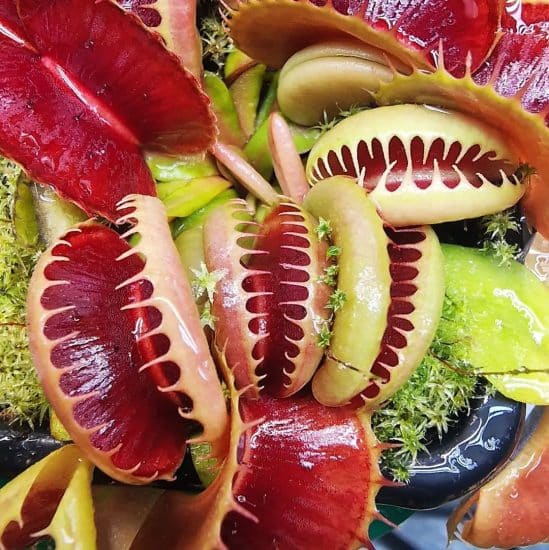
Sadly, the trap dies after capturing three or four insects (or opening three or four times). But don’t worry; plants have multiple traps. Your Venus fly trap will live on (for up to 20 or more years inside!).
According to research published in American Naturalist, Venus flytraps hardly ever eat the insects that pollinate them . . . which makes sense, since that would only encourage the plant itself to die off. (And that wouldn’t be very Darwinistic, would it?).
Fun fact: Even though they’re called Venus fly traps, less than 5% of their diet is from winged insects.
Feeding Carnivorous Plants
Feeding your Venus fly trap isn’t an everyday task; in fact, it’s more of an occasional treat. Aim to feed your carnivorous buddy once every two to three weeks. Keep in mind that these plants do need time to digest their meals, and overfeeding them can actually be harmful.
Don’t stress too much about feeding, though, as Venus fly traps are pros at catching their own meals. In fact, they may go months between bites. Just make sure to provide them with the proper lighting conditions and a healthy environment to thrive in.
Can You Feed a Venus Flytrap Dead Bugs?
Yes, but there’s a little trick to it. In the wild, Venus flytrap plants rely on the movement of live insects for those trigger hairs to activate the trap and start the digestion process. So, if you’ve got a dead bug handy, you’ll need to simulate movement to stimulate the Venus fly trap.
Grab a pair of tweezers, gently place the dead insect inside the trap, and then close the trap using the tweezers. Wiggle the bug around a bit to mimic the struggling movements of live prey, and voilà, you’ve just fed your Venus fly trap a tasty treat.
This is a bit much for me, but maybe you’ll find your true calling as a fly trap parent.
Venus Flytrap Cultivars
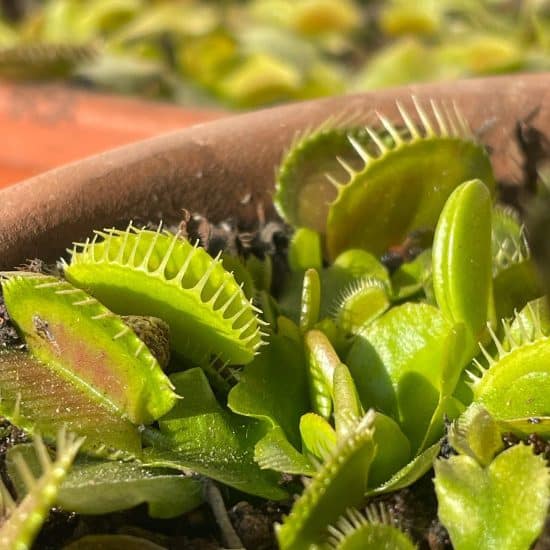
There are dozens of Venus flytrap plant cultivars to choose from and more being developed all the time, but we’ll list some of our favorites:
- Dionaea muscipula ‘Akai Ryu’: Japanese for “Red Dragon,” this cultivar has bright red to burgundy stems, petioles, and traps. Earned the Royal Horticultural Society’s Award of Garden Merit.
- Dionaea muscipula ‘B52’: The largest Venus flytrap cultivar, with traps that can grow to over two inches, and rich red coloring in bright light.
- Dionaea muscipula ‘Fused Tooth’: Looks the same as any other Venus fly trap until summer, when its spines fuse together to create a weird webbed look.
- Dionaea muscipula ‘Wacky Traps’: Nicknamed “Bart Simpson” for its resemblance to the character’s spiky hair, this cultivar grows slowly, has thick petioles and traps, and takes several minutes for its traps to close (slowpoke!).
There’s also a cultivar group called Dionaea Dentate Traps Group that have spines resembling teeth or triangles. Dionaea muscipula ‘Sawtooth,’ ‘Red Piranha,’ ‘Dentate,’ and ‘Jaws’ all fall into this category.
Note that Venus fly traps are being considered for the U.S. endangered species list, and it’s a felony to poach them in their natural habitat. You should only get your plants from nurseries or other trusted sources.
Light
Getting indoor lighting just right is a must for proper Venus fly trap care, especially since most of its energy comes from photosynthesis. (It gets nutrients, not energy, from its prey).
To grow healthily and get the most vibrant colors, Venus fly traps need lots of sunlight over a 10-hour period, at least 5 hours. You can grow Venus fly trap plants outdoors on a sunny windowsill, or indoors under grow lights at a 6500K temperature level and high lumens.
When bringing your Venus fly trap plant into direct sunlight, take it slow by increasing the exposure gradually (acclimation is key to prevent burning!).
Growing Venus flytraps indoors? You can use a grow light, just make sure to place your plant around a foot away and give it at least 12 hours of light a day.
If your Venus fly trap plant isn’t getting enough light, you’ll notice pale green or yellowish leaves, weak growth, or a lack of traps. Too much light, on the other hand, can cause burned or discolored leaves and a decline in the plant’s overall health.
Water
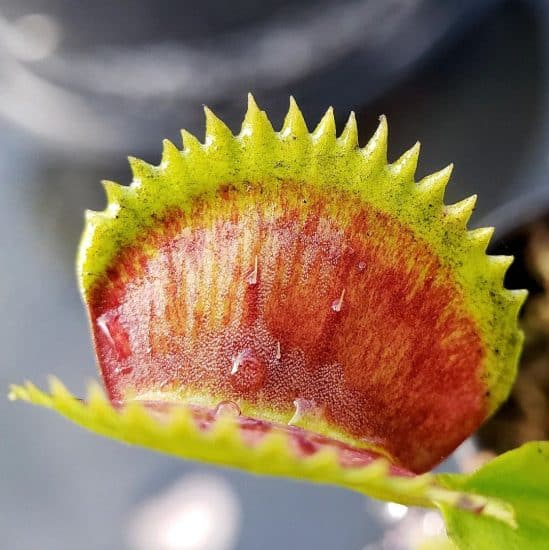
Because of its native habitat, the Venus fly trap has developed a rather picky taste for soil and water.
First things first, Venus fly traps are very sensitive to water with impurities or nutrients, which means forgetting about tap water, river water, pond water . . . even bottled water often won’t do.
Instead, use rainwater, distilled water, or reverse osmosis water. Some people have success with filtered water, just make sure to use a high quality filtration system with your tap water.
You’ll want to place your plant in a tray of about one inch of water, allowing it to soak up the goodness from the bottom. This method not only helps maintain humidity, but also prevents over- or under-watering.
Our Venus flytrap water tips:
- Stick to distilled water, reverse osmosis water, or rainwater to avoid any unwanted mineral buildup that could harm your plant.
- Keep the soil moist but not sopping, and never let it dry out completely. During your plant’s dormancy period in winter, water less, but still keep the soil minimally moist.
- Embrace the tray watering method to maintain the perfect humidity and water levels. Keep an eye on the water level and replenish inch by inch.
- Brown and crispy, wilting and drooping leaves? Not enough water. Additionally, the traps may stop closing in response to prey.
Temperature and Humidity
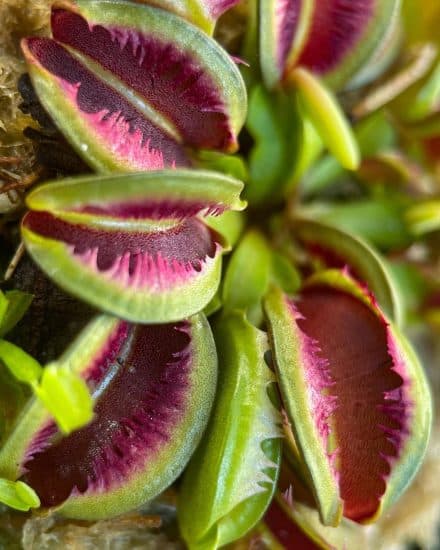
A Venus fly trap prefers temperatures from 70°F to 95°F during the spring and summer, although they can even handle temps over 100°F if watered properly.
Note that the Venus fly trap goes through a winter dormancy, just like other plants in more temperate areas. During this time, they prefer temperatures between 35 and 45°F.
If your Venus fly trap is exposed to excessively high temperatures, the leaves may appear burnt or become crispy at the edges. Low temperatures can cause your Venus fly traps to wilt or droop, and prolonged exposure to cold may eventually lead to its demise.
Venus fly traps grow well in environments with moderate humidity. Signs of too much or too little humidity include wilting leaves or blackening tips. Consider using a humidifier or a pebble tray to maintain consistent humidity.
Soil and Planting
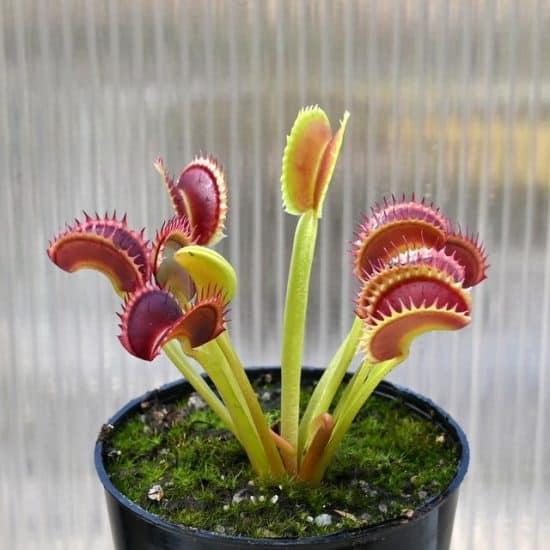
Since Venus flytraps require a unique soil composition and are sensitive to certain materials, it’s essential to know the proper potting techniques and avoid harmful fertilizers.
Venus fly trap plants thrive in carnivorous plant soil, which you can either purchase or mix yourself by combining sphagnum peat moss and perlite in even amounts.
Signs of poor soil include wilting, yellowing leaves, and a decrease in the plant’s ability to capture prey.
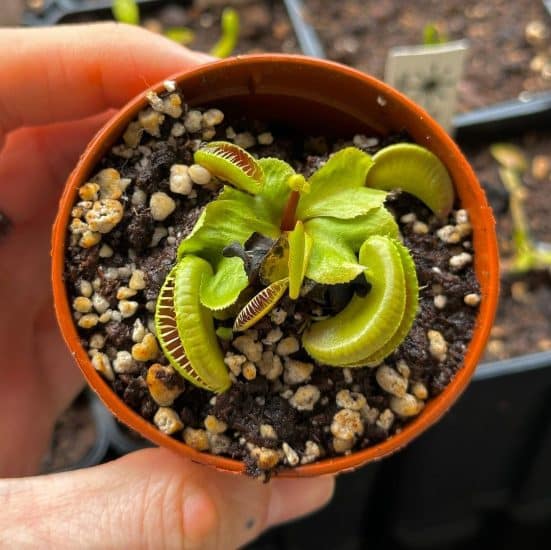
Note: Be sure not to use standard potting mixes like Miracle-Gro. Your plant doesn’t need the minerals and fertilizers they often contain, and these can even damage your Venus fly trap.
Venus fly traps don’t need to be fertilized, since they get all the nutrients they need from the insects they consume.
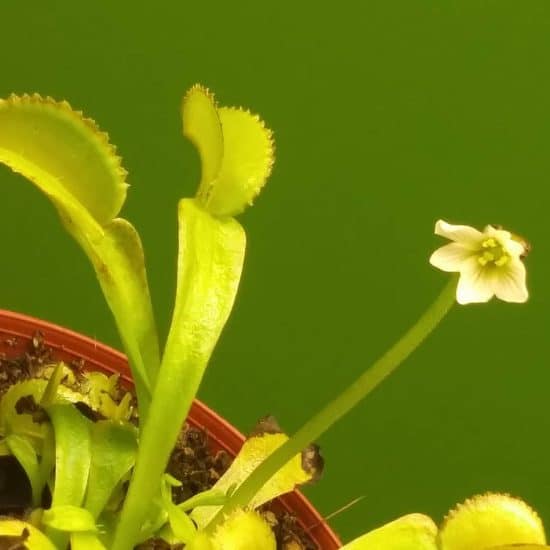
Venus fly traps grow clusters of white flowers in late spring/early summer, but you should pinch these off so the plant can divert more energy to its leaves, or traps.
Repotting
Repot your Venus fly trap annually during the growing months, but don’t do it while the plant is flowering.
The ideal pot for a Venus fly trap should be made of plastic or glazed ceramic. Avoid unglazed or terracotta pots, as they can leach harmful (to your fly trap) minerals into the soil. Your pot should be at least 5-6 inches deep so the roots can grow while the rhizome remains mostly dry.
After repotting, you might see slowed growth for a few weeks and lose a few traps. This is normal as the plant adjusts, and it should be back to thriving in no time.
Propagation
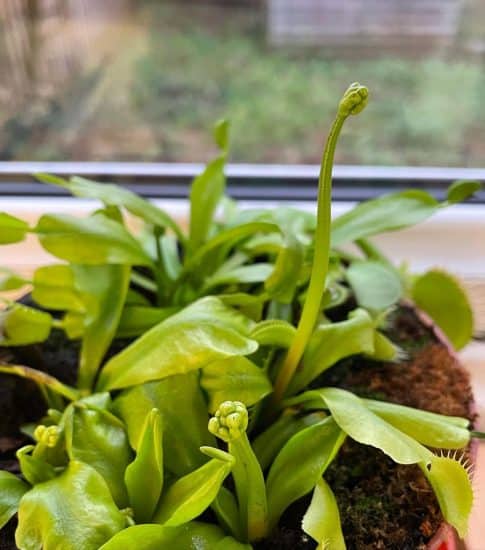
Venus flytrap can be propagated by seeds, leaves, flower stalks, or tissue culture (this is how all those cultivars were invented). We’ll cover flower stalk propagation together, step by step.
(You can also just let your plant grow, since Venus flytraps propagate naturally as they mature, and separate the new plant by division when it’s got enough of a root system).
Propagating Venus fly trap by flower stalk:
- Timing is everything: Keep a close eye on your Venus fly trap as it starts to grow a tall flower stalk, usually in early spring. Be sure to catch your plant just before it begins to bloom, because once it does, you’ll miss your chance for flower stalk propagation.
- Snip, snip: Cut a 3-inch segment from the flower stalk with sterilized shears. Feel free to cut more than one segment if you’d like.
- Let’s get planting: Gently poke either end of the stalk segment just beneath the surface of some moist soil. You can use a soil mix specifically designed for carnivorous plants or whip up your own mineral-free concoction (see the “Soil and Planting” section above).
- Crank up the humidity: Create a mini terrarium by covering the pot with a plastic bag or a clear plastic container to help maintain moist soil and improve your propagation success rate.
- Watch for new growth: Over the next few months, watch your cutting like a hawk (or, you know, just check on it regularly) and look for new growth.
And that’s all! Happy propagating!
Common Issues
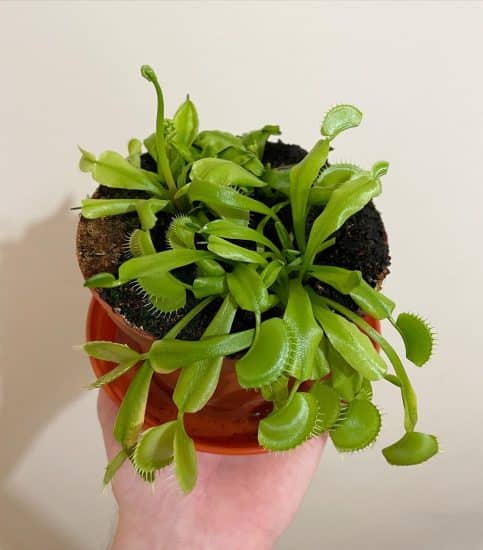
Venus flytraps can run into some problems. Noticing dropping leaves or black leaves? We’ll cover getting your ailing fly trap back on track!
Dropping Leaves
Venus flytraps naturally shed leaves, which means seeing a few black or wilted leaves is no biggie. But if your plant starts dropping leaves left and right, well, it’s time for some detective work. Over-watering or under-watering can both be culprits here.
To fix this leafy dilemma, make sure the substrate is always moist but not soaking wet. Placing a water tray under the pot can help keep consistent moisture levels.
Monitor your plant’s water situation, especially during colder months, and tweak your watering schedule as needed. If things get too dry, slowly up the water intake until you hit that sweet spot.
Black Leaves
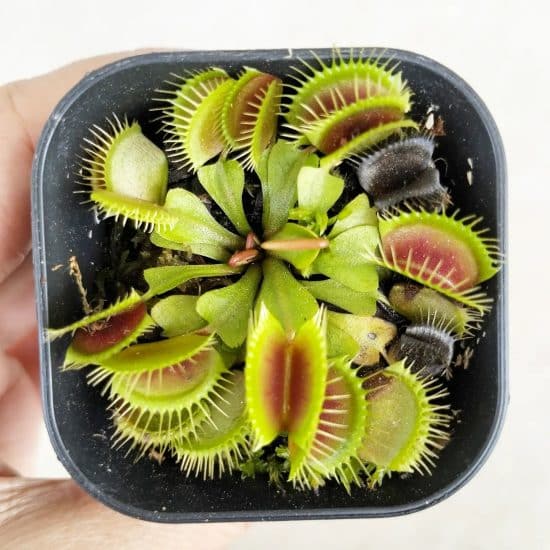
If only one or two leaves are black and dry, don’t worry, it’s just the Venus fly trap’s way of shedding its old leaves. However, if a bunch of leaves turn black all at once and you’re sure your plant isn’t starting its dormancy period (it’s normal for leaves to blacken and fall off as the plant rests then), you might be facing an over-watering or temperature issue.
To banish black leaves for good, keep the soil moist (but not drenched), and give your plant a healthy dose of bright sunlight. You can trim those black leaves once they’re dried out, but it’s not a must. Keep an eye on water and light levels, and your plant will thank you with happy, green leaves.
Pests and Diseases
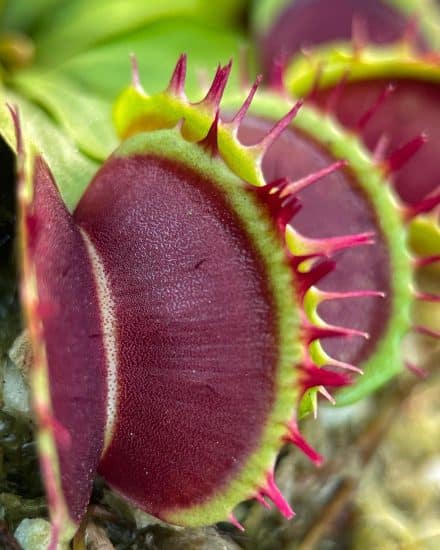
While Venus fly traps can eat insects, they can still be bugged by other pests. We’ll cover how to deal with the most common pests and diseases for this plant, including aphids, fungus gnats, and root rot.
Aphids
Aphids are tiny, pear-shaped critters in various shades of green, yellow, or black. They sip on your plant’s sap and cause deformed leaves and overall weakness. You’ll usually find them hanging out on new growth, stems, or under the leaves.
Solution: Ready to evict these unwelcome guests? Grab a damp cloth and gently wipe off as many as you can. You can also use a spray bottle filled with water to dislodge them. If they’re really stubborn, consider using insecticidal soap or neem oil, but make sure to follow the product instructions.
Prevention: To keep aphids from crashing the party in the future, regularly check your mature plant for signs of pests. Go easy on the fertilizer, as overdoing it can actually encourage aphid populations.
Fungus Gnats
Fungus gnats are tiny black flies. While they’re more annoying than harmful, their larvae can sometimes munch on your plant’s roots. You might see the adults buzzing around your plant or crawling on the soil’s surface.
Solution: Try letting the top inch of soil dry out between waterings. You can also capture adult gnats with yellow sticky traps. For more serious invasions, consider introducing beneficial nematodes or Bacillus thuringiensis (Bt) bacteria, which target the larvae.
Prevention: Ensure your Venus fly trap potting mix has proper drainage. You could also cover the soil surface with a layer of sand or diatomaceous earth to make it harder for the gnats to lay their eggs. Sneaky, right?
Root Rot
This occurs when you’ve overwatered your plant or put it in a soil mix that doesn’t drain well, suffocating its roots. You’ll notice an unpleasant odor, more black leaves, and a darker, squishy, slimy bulb instead of a white healthy one with pink edges (you’ll have to remove the plant from the soil to confirm this).
Solution: Trim away the affected roots with some sterilized shears, then repot your plant in well-draining soil, making sure the pot has at least one drainage hole.
Prevention: Avoid overwatering (your water tray should have one inch of water at all times max) and make sure your plant is in well-draining soil and a pot with drainage holes.
Conclusion
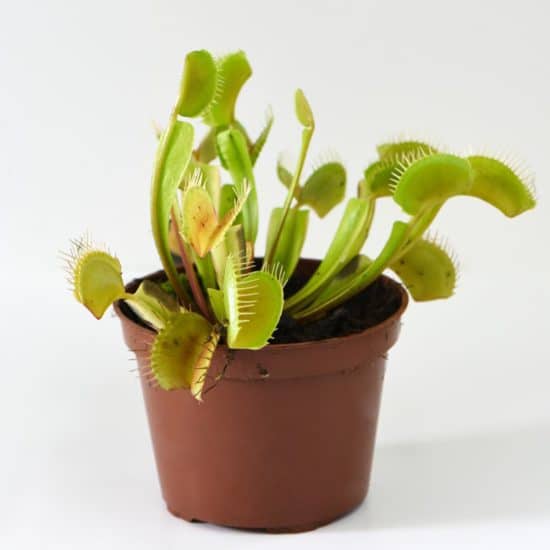
And that’s all for our Venus fly trap care guide! You’re now equipped with all the knowledge you need to become the ultimate caretaker for this extraordinary houseplant.
After all, it’s not every day you can say you have an insect-guzzling marvel of nature sitting on your windowsill!
We hope this guide has been helpful in your journey to raising a happy and healthy Venus fly trap. As always, feel free to reach out to us with any questions or concerns.
If you found this guide enlightening, share it with friends or on social media – we believe everyone should have the chance to experience the wonder of owning a carnivorous plant.
Take care, and happy growing!
FAQ
How long does a Venus fly trap live?
Venus fly traps can live for quite a while! A healthy, happy, and well-maintained indoor plant can live anywhere from 20 to 25 years or more. Like any other plant, the key to longevity is providing optimal growing conditions, like the right soil, water, temperature, and lighting.
Don’t forget to let your Venus fly trap go through its winter dormancy period, too, as this is crucial for its overall health and survival.

